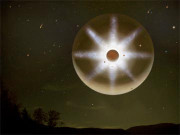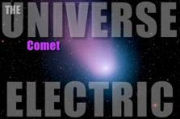|
|
Newton's Electric Clockwork Solar System
by Wallace Thornhill
|
|
April 21, 2009
|
|
|
|
We are told that gravity rules the cosmos. The story
of the big bang, the origin of galaxies and stars, and our
ultimate fate are founded on this belief. But the March 2009
Astronomy magazine carries the surprising headline, “Is
there something we don't know about gravity?” The
question should be, “why do we think that physicists know
anything about gravity beyond mathematical descriptions
of its observed effects?”
|
|
|
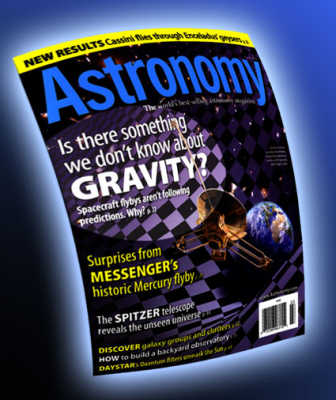
[Click to enlarge]
|
|
|
All that modern physics has done is to obscure the need for
serious investigation of an unsolved problem. Even some effects
attributed to the action of gravity, like the bending of light,
need not have anything to do with gravity. Indeed, we are so
far from understanding gravity that we don't know the right
questions to ask.
For example, orbital dynamicists have long known that Newton's
law of gravity applied to the solar system predicts chaos in the
short-term—perhaps a few million years—not aeons-long clockwork
stability. So the first question that must be asked is why does
the solar system appear to run like clockwork? This is not done
in the usual history of the solar system. A strict application of
Newtonian dynamics would render retro-calculation of planetary
histories impossible. How can you concoct a history if you have
no idea where the group of actors were in the past? Without
understanding the cause of stability of the planetary system,
the foundation of geology and planetary science is missing! We
cannot explain the origin of the solar system.
|
|
|
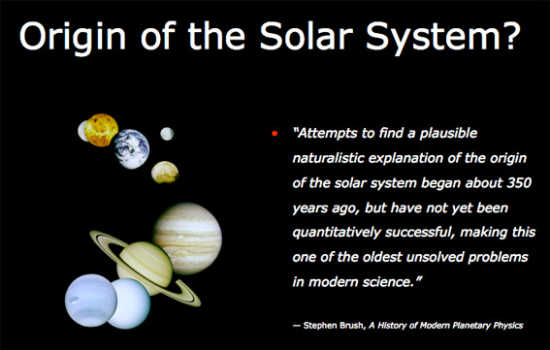
[Click to enlarge]
|
|
|
|
To provide clockwork stability there must be a
feedback mechanism to control orbital spacing. That
requirement can be met if the gravity (mass) of a planet is variable.
I have argued in
Electric
Gravity that this is possible by changing the electrical
charge state of a planet. In summary, the Earth's gravity and
surface charge causes radially oriented electrostatic dipoles
to be formed by most atoms inside the Earth with the inner pole
positive and the outer pole negative. This effect is due to the
almost 2,000-fold more massive nuclear particles compared to the
orbiting electrons. If all subatomic particles are composed of a
resonant system of positive and negative charges they are also
subject to distortion in the radial electric field to form an
electric dipole. Since the particles are free to rotate, their
dipoles will line up and the weak dipole force of each particle
will add up to produce the effect of gravity.
|
|
|
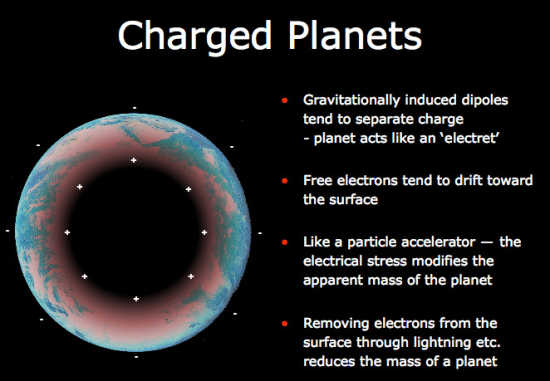
[Click to enlarge]
|
|
|
If the electric field within the Earth changes, the amount of
this dipolar distortion will change and the force of its gravity
will change. Charge exchange among planets is the key to the orbit
stabilizing mechanism in an electric solar system. The
'clockwork' of the solar system is governed by gravity and its
stability provided electrically.
What we need to find is a means of transferring charge between
planets that may provide an orbit stabilizing influence.
|
|
|
|
|
|
Electrically Modified Newtonian Dynamics (EMOND)
In 1983 Mordehai Milgrom of the Weizmann Institute of Science
in Israel proposed a modified Newtonian dynamics (MOND) to describe
galactic motions. As explained in
Electric
Galaxies, the motion of galaxies is not gravity dominated.
MOND may not be necessary for galaxies. However, some form of
MOND is needed to explain stable planetary motion within the
solar system.
Conventional celestial mechanics never thinks of the mass of a
planet as a variable. However, if the electrical charge on a
planet can directly affect its apparent mass to a significant
degree, a new and important consideration is introduced to celestial
mechanics. Newton's well-known gravitational equation has the force
(F) between the Sun and a planet as:
F = GMm/r2 where
G = the 'constant' of gravitation,
M = mass of the Sun,
m = the mass of the planet, and
r = the distance of the planet from the Sun.
However, G is measured at the Earth's surface and used in this
equation for the Sun and every other planet. It is simply
assumed that G is universal and has the same value
for all celestial bodies.
G has the peculiar dimensions of length cubed, divided by mass
and by time squared
([L]3/[M][T]2). A. K. T. Assis argues that
dimensional constants like G should not appear in the laws of physics.
They “must depend on cosmological
or microscopic properties of the
universe.” [1]
Garcia-Berro et al state, “Questioning
the constancy of fundamental parameters is essentially trying to understand
a more fundamental theory behind.”
[2]
We conceal our ignorance of any underlying physical mechanism
by tolerating dimensional constants. If mass is an electrical
variable, G cannot be constant. Assuming G to be universal as
well gives rise to calculated masses and densities of celestial
bodies that lead to further conjectures cantilevered upon the
already dubious assumptions. Stellar and planetary structure
and composition are based upon this erroneous conviction.
For example, by using G, measured on Earth, the planet Saturn
appears to have a lower density than water!
Strong circumstantial evidence for a different gravitational
'constant' for each body at different times comes from the
difficulty of establishing its value on Earth. 'G' is the most
inconstant of physical constants. [3]
The small variations in measurements in modern times are dwarfed
by evidence from prehistory. Early dinosaur discoveries forced
scientists to conclude that the gigantic animals must have been
waders to offset their crushing weight with the buoyancy of water.
However, fossil footprints show them as fleet-footed land animals -
an impossibility in Earth's present gravity.
“The force of gravity at the surface
of the earth must have been very much lower than it is today.”
[4] Whatever happened to
the dinosaurs was far more dramatic than climate change from a puny
asteroid impact.
The Electric Universe concept of gravity illustrates this “more
fundamental theory behind” the conceptual curtain of G.
The
Sun is a positively charged anode and the focus of a galactic
glow discharge. Most of the voltage difference between the Sun
and its interstellar environment occurs at the 'virtual cathode' -
the solar wind boundary known as the heliopause. The heliopause is
not simply a supersonic shock boundary but a thin protective plasma
sheath or 'double layer.' The double layer boundary accelerates
solar wind ions into deep space at cosmic ray energies. So cosmic
rays give a useful measure of the driving potential of the Sun,
estimated to be of the order of 10 billion volts. The order of
magnitude and direction of the electric field inside
this double layer boundary fits the electric model of interplanetary
space as the 'positive column' region of a glow discharge. It is
characterized by a weak but constant electric 'drift field.'
[5]
|
|
|
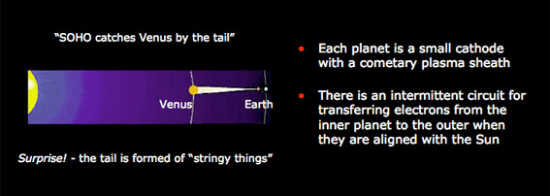
[Click to enlarge]
|
|
|
Each planet acts as a small secondary cathode in this solar glow
discharge and develops an invisible cometary plasma sheath, the
tail of which stretches away from the Sun in the plane of the ecliptic.
The cometary plasma sheath of Venus was found to stretch as far as the
Earth during inferior conjunction. Researchers were puzzled by the
coherent "stringy" nature of the Venusian plasma tail.
[6] The stringiness is
confirmation of Birkeland currents stretching between Venus and the
Earth, which transfer charge between the planets. The same kind of
electrical exchange takes place between Earth and Mars during opposition,
giving rise to the 'blue clearing' of the Martian atmosphere and the
electrically driven global dust storms on that planet. Many planetary
plasma tails have been found to brush across the plasma sheath of the
planet in the next outer orbit. This brushing constitutes an intermittent
circuit for transferring charge between adjacent planets when they are
aligned with the Sun.
It suggests the following mechanism for orbital adjustment and stabilization:
The total orbital energy of a planet about the Sun is the sum of
the planet's kinetic energy (KE) and its gravitational potential energy (PE).
That is, if
KE = 1/2mv2 and
PE = -GMm/r,
using the earlier notation and where v is the velocity of the planet
in its orbit, then the total energy (E) of a planet in orbit about the Sun is:
E = 1/2mv2 – GMm/r.
For the simple case of a circle,
v2 = GM/r so that
E = 1/2m(GM/r) - m(GM/r) or,
E = -m(GM/2r) and
r = m(-GM/2E), that is (assuming the mass of the Sun (M) remains constant),
The orbital radius of a planet (r) is directly proportional
to the planet's mass (m) for a given orbital energy (E).
[Note that the mass of an electrically shining Sun does not steadily
diminish at the calculated rate of 4.38 x 109 kg/sec by converting mass
into radiant energy - as the standard model assumes. However, the Sun does
lose mass in the solar wind at about 30% of that rate. It is a trivial rate
of change in M. But a more significant and sudden change in M may occur in
response to variations in the local galactic electrical environment].
|
|
|
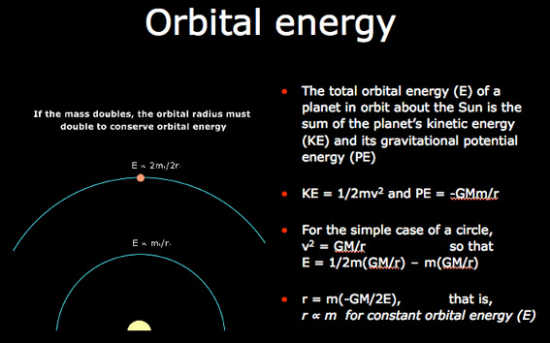
[Click to enlarge]
|
|
|
If the mass of an inner planet is reduced by charge exchange with
the next outer planet, which changes the subatomic dipole distortion,
the orbital radius of the inner planet must decrease proportionally
to conserve energy. Similarly, the outer planet must gain mass and
its orbit expands to conserve energy. The closer the encounter between
two planets the more substantial the charge exchange and the greater
the resultant orbital adjustments. It seems a highly effective means
for collision avoidance and for quickly spacing the planetary orbits
to minimize interactions—provided the inner planet diminishes its
charge polarization (reduces its mass) in the exchange and the outer
planet increases its polarization (increases its mass). Is this possible?
A substantial transfer of electrons from the inner planet to the
outer planet along a (visible or invisible) cometary tail may produce
the effect we require. Gravitationally induced charge polarization
in neutral atoms forms a weak radial electric field inside celestial
bodies. Planets behave like spherical electrets with a radial electric
dipole polarization. If we remove some of the surface electrons the
internal polarization is diminished causing a proportional diminution
of the apparent mass and gravity of that body. Conversely, if electrons
are added to a body its internal polarization increases, causing a
proportional increase in mass.
|
|
|
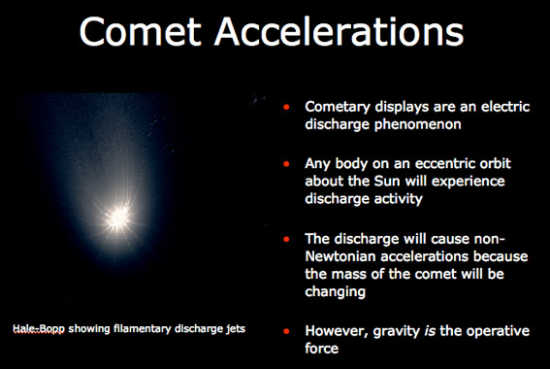
[Click to enlarge]
|
|
|
As a secondary cathode in the solar discharge, each planet
normally supplies some electrons to the solar wind. In the
case of an intense cometary discharge, like that memorialized
for Venus, the continuous discharge can circularize and shrink
the planet's orbit. It is an effective capture
mechanism that is unavailable under Newton's gravitational
law. Venus now has the most circular orbit of any planet. And as
the plasma tail of an inner planet sweeps across the plasma
sheath of an adjacent outer planet, electrons are transferred
via Birkeland current filaments. The inner planet loses mass
and its orbit shrinks toward the Sun. The outer planet gains
mass and its orbit expands away from the Sun. Orbital
eccentricity is damped by 'cometary' charge exchange with
the solar wind, which varies with distance from the Sun.
The eventual result is that all planets settle into low
eccentricity orbits where they disturb each other the least.
This is an Electrically Modified Newtonian Dynamics (EMOND).
It is distinct from MOND which merely twiddled Newton's law
to match the observations. MOND is NOT a theory.
EMOND is a theory that requires no new
physics.
|
|
|
|
|
|
Gravitational Mysteries Noted in Astronomy Magazine
Astronomical Unit (AU) Inflation
“The latest measurements by Pitjeva
and Standish suggest the AU is increasing about 23 feet (7 meters)
per century. But the AU should not change at all!”
EMOND provides a mechanism that can be tested because the Earth's orbit
expansion should be a discontinuous function with discrete 'jumps'
following major solar storms and at Venus' inferior conjunction.
At present the measurements have only been done between the Earth
and Mars, which doesn't rule out the possibility that the Sun's
mass (M) is changing. In that case, all planetary orbits should
change proportionally and simultaneously. This is an important
experiment to carry out when a radio transponder is placed on
another body in the solar system (other than the Moon).
Mercury's Perihelion
Newton's laws do not explain the rate of precession of Mercury's
perihelion. It is offered as 'proof' of the validity of Einstein's
theory of gravity. However, Einstein's theory does not explain
gravity so we must ask if EMOND can provide the answer. Perhaps so,
since subtle changes in the orbit of Mercury will occur as a result
of variable charge transfer from the solar wind due to the planet's
eccentric, tilted orbit. (See
More
on Mercury's Mysteries). Mercury is close to the Sun and should
experience a decreasing orbital eccentricity by charge exchange
with the solar wind.
Lunar Eccentricity
The Moon's orbit is becoming more elliptical at a rate three
times faster than can be explained by tidal factors. The Moon
is at the solar wind plasma potential, judging by its lack of
any substantial plasma sheath. So it has no significant damping
of eccentricity via charge exchange with the solar wind. Meanwhile,
for some months each year at full phase the Moon passes through the
Earth's plasma sheath, which will give a nudge to the Moon's orbit
by transferring charge from the Earth. The repeated electrogravitic
'nudge' in the same region of the Moon's orbit will cause an
unaccounted for increase in eccentricity.
The 'Pioneer Anomaly'
Tracking data has shown that both Pioneer 10 and 11 spacecraft
have slowed at a constant rate while travelling out of the solar
system in opposite directions.
I
solved this anomaly in 1999 in terms of the Electric Sun model.
It is the only model that explains why the decelerating force remains
constant with distance from the Sun, something that gravity or any
other diminishing inverse square law force cannot do.
Oddball Orbits
It has long been known that comets have "oddball orbits"
that do not obey Newton's law of gravity. The anomalous accelerations
are due to the motion of an electrically discharging body in the Sun's
weak, radial electric field. In recent years “anomalous orbital
energy changes” have also been observed for spacecraft that flew
by the Earth for a gravity assist. In their time away from the Earth,
the spacecraft establish a charge polarization with respect to the
solar wind. When they again encounter the Earth, their masses will
have changed. The effect on spacecraft acceleration with respect to
the Earth is of the same variable nature as the "non-gravitational"
acceleration of comets with respect to the Sun.
|
|
|
|
|
|
SUMMARY
The modern knee-jerk response to anomalous data is to propose "a
new physics." That way, the belief goes, fame and fortune beckons.
"New physics" is the main proposition in the Astronomy article.
It shouldn't be. Surprise results are a signal that our understanding of
the problem is faulty. We should be re-examining the assumptions that
underpin our models rather than adding more complexity to patch over the
cracks. The vital requirement in this case is to understand gravity!
We observe falling and orbital motions and describe them with equations
that we call gravitation laws. We think that we understand gravity
because the equations seem to work. [7]
But our celestial observations span a very brief and recent interval
of human experience. At the same time, scientists regard global legends
about bellicose activities of planetary gods in the heavens as 'myth' -
read 'fiction.' The stories tell of battles in the skies between
planetary gods hurling thunderbolts. The thunderbolts depictions
bear no relationship to the puny sparks we call lightning. Instead,
the 'thunderbolts of the gods' find their morphology duplicated in
the highest energy electric discharges generated in plasma laboratories.
The remarkable juxtaposition of planets with the thunderbolt as their
'weapon' goes unremarked. Furthermore, the mythmakers described the
planets as spheres, which calls for close encounters with the Earth
in prehistory. It is not the myths but the modern story of
the clockwork Newtonian solar system that is fiction.
|
|
|
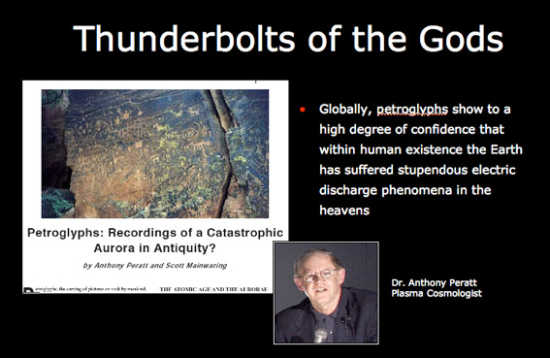
[Click to enlarge]
|
|
|
The confusion about any role for electricity in celestial
dynamics has come about because of our ignorance of the
electrical nature of matter and of gravity. The classical
signposts to an understanding of gravity were in place at
the beginning of the 20th century, but after
the terrible world wars it seems people were looking for
heroes with a new vision. Einstein became an overnight
idol of genius and his geometric metaphysics the new fashion
in science. The dedication to the Einstein mythology has become
so entrenched that to say “the emperor has no clothes”
invites ridicule. But over almost a century there has been an
astronomical price to pay for adulatory adherence to dogma.
A recent review of the history of astronomy concludes,
“The inability of researchers
to rid themselves of earlier ideas led to centuries of stagnation.
An incredible series of deliberate oversights, indefensible verbal
evasions, myopia, and plain pig-headedness characterize the pedestrian
progress along this elusive road for science. We must be constantly on
our guard, critically examining all the hidden assumptions in our
work.” [8]
The public must be made aware how science actually operates and
is protected from scrutiny. It will require the kind of fearless
investigative journalism we often see in politics. Science reporters
must refuse to bow to the expert and the lazy dissemination of academic
propaganda.
Newtonian dynamics does not guarantee stability in a many-body
gravitational system; quite the reverse in fact. The electrical
nature of mass and gravity simply adds a new dimension to Newton's
celestial mechanics. No 'new physics' is required.
“History serves as an appellate
court, ready to reverse the judgments of the lower courts, which are
limited by the myopia of contemporaneity.”
[9]
Wal Thornhill
|
|
|
|
|
|
REFERENCES
[1] A. K. T. Assis, The
Principle of Physical Proportions, Annales de la Fondation
Louis de Broglie, Volume 29 no 1-2, 2004, p. 152.
[2] E. García-Berro et al.,
Astronomical measurements and constraints on the variability
of fundamental constants, Astronomy & Astrophysics Review
(2007) 14:113–170, p. 115.
[3] Earth's magnetic field
'boosts gravity' New Scientist, 22 September 2002,
“Newton's
constant, which describes the strength of the gravitational pull
that bodies exert on each other, is the most poorly determined
of the constants of nature. The two most accurate measurements
have experimental errors of 1 part in 10,000, yet their values
differ by 10 times that amount. So physicists are left with no
idea of its absolute value.”
[4] L. Endersbee, A Voyage
of Discovery: A history of ideas about the earth, 2005, p. 208.
[5] C. Lacombe et al., Evidence
for the interplanetary electric potential? WIND observations of
electrostatic fluctuations, Annales Geophysicae (2002) 20: 609–618.
[6] Planet's tail of the
unexpected, New Scientist, 31 May 1997, p. 18.
[7] Op. cit., L. Endersbee, p. 107.
“The question of the physical basis
of the force of gravity is quite profound, and continues to be studiously
avoided by most of the physicists and astronomers. We are all aware of
the consequences of the force of gravity, but the cause of the force
of gravity remains a mystery.”
[8] Simon Mitton, reviewing The
Milky Way by Stanley L. Jaki, New Scientist, 5 July 1973, p. 38.
[9] Robert K. Merton, The Matthew
Effect in Science: The reward and communication systems of science are
considered, Science, Vol. 159, pp. 56-63.
|
|
|
Permalink to this article.
Public comment may be made on this article on the
Thunderbolts Forum/Thunderblogs (free membership required).
Please visit Wal's holoscience website.
|
|
|
|
|
|
|








